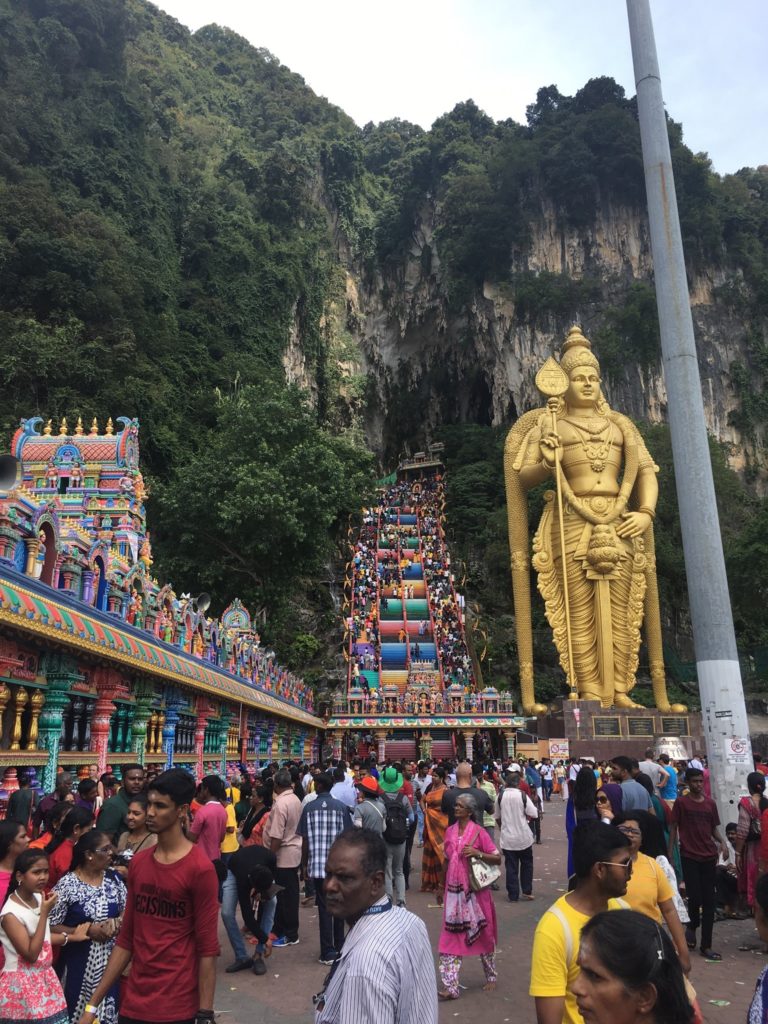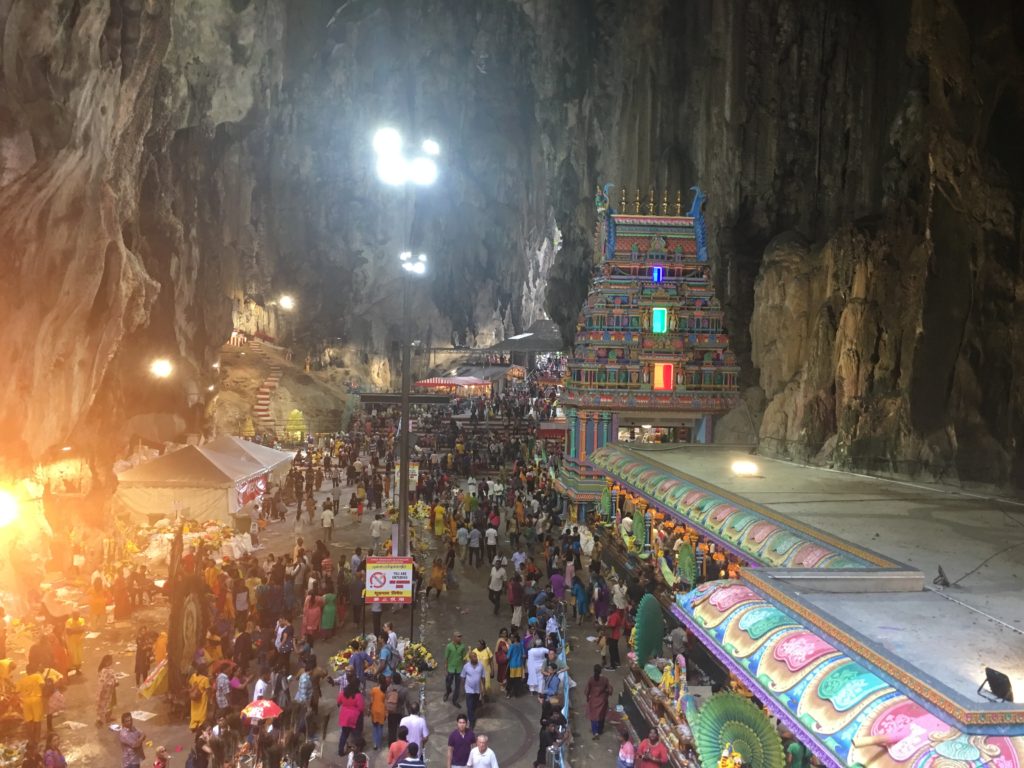Hindu Culture in Malaysia: Thaipusam at the Batu Caves
Written and photographed by Michael Goonan
Malaysia is easily the most interesting country I have visited thus far in Asia. A melting pot of cultures and religions, it is home to Malay Muslims, Indian Hindus, Chinese Buddhists, and folk practitioners, as well as an array of indigenous groups. People of Indian descent make up about seven percent of the population in Malaysia, most of them Tamils who are descendants of those who immigrated to Malaysia from Tamil Nadu during the period of British colonization in the 19th and early 20th centuries. As someone who is particularly fascinated by Indian culture (and its delicious cuisine!), and who has not yet had the opportunity to visit India itself, I was excited to explore this interest during our visit to Malaysia.

If you Google “things to do in Kuala Lumpur,” without a doubt the Batu Caves will be one of the first things you encounter. This impressive sight, located on the outskirts of the city, is an elaborate group of Hindu temples and shrines located around and within limestone caves on a mountainside. Unbeknownst to us, it turned out that our first full day in Kuala Lumpur was Thaipusam, the biggest event of the year at the caves. At the center of the celebration is Murugan, the god of courage, wealth, and wisdom, whose biggest statue in the world is located at the Batu Caves.
Hindu pilgrims walk barefoot for several miles to the caves before climbing 272 stairs to the temple of Murugan. Over a million people were in attendance this year. We encountered several people asleep in the temples, exhausted from their long journey! As curious tourists rather than ardent devotees of Murugan, we decided to take a Grab ride and keep our shoes on for the stair climb. I realize that this makes us excruciatingly lame, but like a young, fictional George Washington, “I cannot tell a lie.”

The weather for Thaipusam could not have been much better. The sun was shining, and the temperature was around 85° Fahrenheit (30° Celsius). This was a very welcome break from the frigid January we had been experiencing in Korea before arriving. When we got to the Batu Caves, it was a chaotic and lively scene. It was not clear to us where we should enter, and so we first wandered into a line at the entrance to the Divine Life Society Temple near the caves. Unbeknownst to us, we had just entered a line for free food, or prasada, at the temple! Seeing how confused we looked, our new friend, Kumar, who was standing in front of us in line, informed us of where we were and what was happening. Few people in this world love Indian cuisine more than I do, so you would be right in guessing that I was over the moon. It appears that my curry senses were tingling and my subconscious mind duly directed us to exactly where we needed to be.

As we sat for prasada, we soon discovered that this temple engaged in the South/East Indian custom of eating everything with one’s hands. This was the first time I had encountered this custom, but it did not phase my girlfriend, Emily, who had encountered it in Sri Lanka. I wish I could say I dug right in, but I must admit to cheating and using the banana chips to scoop my delicious vegetarian curry. “Delicious and nutritious,” as the saying goes! After eating, we took some time to browse the temple grounds, eventually arriving at the table where they were selling books by the swamis upon whose teachings their practice is based. Emily and I bought one book each, and we were subsequently given three more books for free! They provided interesting reading for the rest of our trip.

Views of the temple and the crowd inside the Batu Caves
Finally, we said our goodbyes and made our way to the grounds of the Batu Caves. We discovered a large market at the foot of the caves, with vendors selling various foods, jewelry, statues of the Hindu deities, and more. Many people were shaving their heads as an offering to the gods and covering their newly shaved heads in orange powder. Emily and I bought colorful Indian attire, and I amused some of the locals as I struggled to don my new orange shirt patterned with mantras and the Om symbol. From here, we approached the temple at the base of the cave. Here, we encountered many sleeping devotees and many people praying at various shrines to the deities. There was a large line to take a selfie with a statue of a cow – a sacred animal in the Hindu religion. We were struck by the programmed nature of it all. People gathered wherever they chose for a variety of purposes. Some sat in groups talking. Some slept. Some were deep in meditation or prayer.
As we got ready to make the climb to the temple at the top, we encountered a procession of people performing some of the traditional Thaipusam austerities. Some pilgrims, looking to gain the favor of Murugan and purify themselves of their sins, carried elaborate statues and pictures of the god on their heads, attached deep into the skin of their bodies with hooks. Ouch! Apparently, this was historically a more popular practice than it is today, as it is discouraged by many of the Hindu religious authorities. But that did not stop those truly determined to gain the favor of the god in this way.

As we climbed the staircase to the cave, we were struck by the great diversity of people there: families carrying young children, elderly devotees struggling with each barefoot step, curious Malay Muslims, and Malaysian Chinese tourists. Interestingly enough, we saw only a handful of Western tourists there. As we approached the top of the staircase, we began to encounter the many monkeys that live on the mountainside next to the caves. These monkeys have no problem getting close to people, looking for any opportunity they could find to steal some food or make some mischief. Finally, we arrived at the temple complex within the caves. To say it was awe-inspiring is a definite understatement. The colors and ornate architecture, the scattered groups of devotees – many of them asleep – and the stunning natural atmosphere are truly one of a kind.

Like most things in life, words and pictures can only go so far in recreating the atmosphere of an event as unique as Thaipusam at the Batu Caves. If you are planning to travel to Malaysia during late January or early February, it is a festival that you must experience for yourself. It will surely be a unique and unforgettable experience.
The Author
Michael Goonan teaches English at Nampyeong Elementary School in Naju. Originally from Scranton, Pennsylvania, he’s also lived in the Czech Republic, New Zealand, Australia, and the Netherlands. He blogs about travel, culture, politics, and more at Goonan.us.





